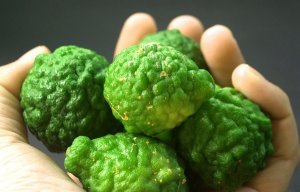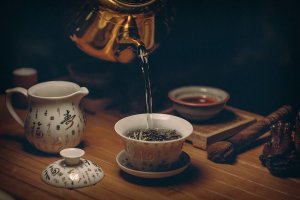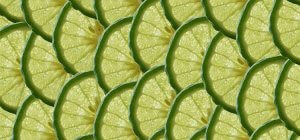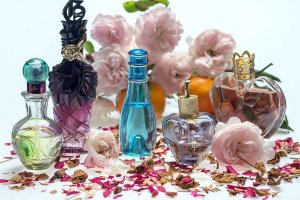There are many essential oils that make up the top heart and base notes of a fragrance, and, in general, the most prevalent oil in the top notes of scented products is that of bergamot.
Commonly found throughout the Mediterranean, bergamot is a fragrant fruit that is about the size of an orange, yet similar to a lime in color.
It comes from the tropical citrus Bergamia plant which can grow up to four meters high with star-shaped white flowers and smooth leaves that bear a pear-shaped fruit.
The fruit is a hybrid of a lemon and an orange, and its fragrant oil is a major component in many perfumes, colognes and scented soaps. It is the “star” scent that renders the inimitable flavor and aroma of Earl Grey tea.
Sometimes known as a bergamot orange, this fruit has more of a lemony taste except sweeter.
It is said to actually be a ‘cross-breed’ or hybrid of bitter orange and lime.
Bergamot essential oil is among the world’s most unique and delicate citrus oils because of the exclusivity of where it is grown, the ironic fact that it is a bitter fruit that produces a sweet oil, and its ability to create an uplifting and calming environment.

Italians have used bergamot for years to reduce stress and rejuvenate the skin, and in Greece, the unripe fruits are used as sweet-meats, eaten by the spoonful as a dessert or with coffee.
Bergamot And Skin Care
Bergamot’s distinctive citrusy scent is a complex element that our perfumers use in both men’s and women’s perfumes and personal care products. It can also be found in cologne, toiletries, skin care products and cosmetics.
Recent studies indicate that bergamot essential oil also aids in keeping skin youthful, and this is the reason it is used so extensively in cosmetics and skin care products such as: soaps, creams and lotions.
Bergamot contains a cicatrizant, which means it promotes healing through the formation of scar tissue. It also helps to create an even and attractive skin tone by balancing the uniform distribution of pigments and melanin.
Bergamot is a commonly used application for the elimination of unsightly acne scars.
Bergamot and Earl Grey Tea
The tea derives its moniker from Earl Grey, who was the Prime Minister of Great Britain in the 1830s. How this specific blend of tea became associated with him is not exactly known, but stories and legends abound.
One tale suggests that it was an accidental creation that occurred when Chinese diplomats shipped a container of tea and bergamot oranges together to England.
It is said that while in transit, the essence of the fruit was absorbed by the tea. Another account speaks of a Chinese visitor to the Grey estate who.created the tea blend to improve the unpleasant mineral taste of the water.
Still another story suggests that a Chinese official sent the tea to Charles Grey as a thank you gift for saving his son.

The exact truth will always remain a mystery, but for the last two centuries this blend has been a staple among the English. However it originated, the tea is hugely popular today, and has spawned other varieties, such as Lady Grey tea, which includes lemon and Seville orange in addition to bergamot.
Bergamot Is A Unique Essential Oil
Our team understands and respects the fact that there’s something about the oil from the bergamot orange that is unlike anything else in the world, and it simply cannot be replicated. For that reason, this citrus scent is highly coveted. Closing one’s eyes and inhaling the slightly sweet, complex bouquet of bergamot is like a sensual magic carpet ride over the beautiful, lush, rolling hills of Southern Italy.
Often, the oil is blended with other popular essential oils, such as lavender and cedar-wood, to create the unique scents that have made us an innovative and versatile leader within the perfume industry.
Bergamot is unlike other citrus fruits in several ways. For one, it is seriously sour in taste and not eaten fresh like sweet oranges even though they are an excellent source of vitamin C, potassium, vitamins B1, B2, and A. For another, bergamot has a distinctive, heady fragrance and flavor.
It is highly aromatic, and the rich deposits of essential oils are extracted from the rind, which have a citrus-like aroma but also a spicy undertone. Bergamot oils require a cold compression process, which differs from other essential oils, which are usually derived via steam distillation.
Bergamot was a highly coveted essential oil during the 15th to 16th century when it was used in both teas and perfumes. Until the mid-19th century, its extraction process was done by hand and was quite labor-intensive, as 200Kg of fruit are required to produce one liter of essential oil. Today, the majority of bergamot essential oil production takes place in southern Italy, as attempts to cultivate it elsewhere have not been that successful.

The fruit itself, which resembles a miniature orange, is very bitter and not edible when raw. When exposed to light or oxygen, this essential oil will lighten to a yellow or pale olive brown. It is the dried peel of this essential oil that gives Earl Grey tea its unique flavor and bergamot is also used as an ingredient in Turkish delight.
The zest of the bergamot fruit tastes the same way it smells: tart, acidic, highly fragrant, and spicy. Both the zest and the flesh are used throughout Europe as a flavoring in cookies, custards, jams, marmalades, syrups, and cocktails to other sweet dishes to offset the sugar. It is also mixed with mayonnaise or pesto and served as a condiment with fish or meat entrees.
The Story Behind Bergamot
The earliest records trace the bergamot tree back to Southeast Asia and possibly parts of Italy, but its complete history and development aren’t fully known. Its name derives from the Italian city of Bergamot located in Lombardy, where the essential oil was originally sold. Italians have used bergamot in folk medicine since the sixteenth century as a remedy for fever and as an antiseptic treatment. This prized essential oil has also been widely used in both perfumery and the culinary arts.
The Oswego tribe of American Indians in upstate New York drank “Oswego Tea” (aka bee balm)made from the leaves of the perennial bergamot plant. They would brew the tea out of the leaves of the plant, which is a process they taught to the early European settlers. They used it for medicinal purposes and it was also one of the drinks American colonists turned to during their boycott of British tea after The Boston Tea Party. It was a defiant and positively non British alternative. It gets it alternate name of bee balm from a popular salve derived from its resin that can be used to soothe bee stings.
According to recent research conducted in Italy, Bergamot essential oil has a wide variety of uses in aromatherapy application, respiratory problems, skin diseases, mouth and urinary tract infections. A primary component of the original fragrant eau-de-cologne that was all the rage of many 18th century European courts, bergamot oil uplifts the human spirit and enhances mood. It also has a number of uses in aromatherapy. It’s high content of chemicals esters and alcohols make it a gentle oil to use for digestive difficulties, stress, infectious wounds, and as an insect repellent.
9 Interesting Facts About Bergamot
Origins Of The Word Bergamot
Although most believe that bergamot was named after an Italian town, a French company that makes bergamot-scented candles and has been around for centuries states that the word comes from the Turkish beg-armade, meaning lord or prince’s pear.
Bergamot Came To Italy Via The Canary Islands
Christopher Columbus is believed to have bought the bergamot tree back to Northern Italy on a voyage from the Canary Islands to Barcelona, Spain. From there, it was introduced to the Italian city of Bergamo, Lombardy, where the oil is reported to have been first produced.
Calabria Is The World’s Largest Cultivator Of Bergamot
Over 90% of Earth’s supply of bergamot comes from this location in southern Italy, which is responsible for producing 125 metric tonnes per year. Bergamot oil is also produced in smaller amounts along the Ivory Coast, Argentina, Turkey, Brazil, and Morocco, but the oils produced in Calabria are considered to be of the highest quality in the international trading market.
Bergamot Has Insecticidal Properties
Often an ingredient in do-it-yourself insect repellants, it is a safer and gentler alternative to harsher store-bought products.
It Is Very Popular In Finer Perfume Manufacture
Bergamot is a highly sought after perfume ingredient because it has the ability to balance the mix of aromas, thereby enhancing the fragrance. Its powerful scent often acts as the top note.

It Takes 100 Bergamot Oranges To Yield 3 Oz of Essential Oil
Sweet-smelling bergamot essential oils are extracted during the period between November and January when the fruits are almost ripe. They are cleaned first and then extracted before being used in both perfumery and food flavoring.
It’s The Only Citrus Fruit To Have An Anti-Cholesterol Effect
Bergamot is the only essential oil to contain melitidin and brutieridin, two polyphenolic compounds that are proven to be comparable to statins which help to maintain healthy cholesterol levels.
Bergamot Oil And The Black Arts
In the practice of voodoo and witchcraft, bergamot is said to ward off evil and danger. It also is said to attract money to those who wear it. Magically, it is strongly associated with the Sun, and is used in rituals to clear the mind and spirit.
Bergamot Oil Is Also Known As The Finest Flower of Citrus
This moniker derives from the subtlety and complexity of bergamot oil when compared with other forms of citrus. It is fresh and fruity but also bitter and slightly floral with a mild, spicy tone that is reminiscent of lavender.
Alpha Aromatics And Our Use Of Bergamot
We’re an internationally acclaimed manufacturer and supplier of custom fragrances for use in premium perfumes, personal care products, candles and diffusers, scents for home products and odor neutralizers.
Our master perfumers understand and respect the power of bergamot, which is used in many of our formulations. We have been creating fine perfumes for decades, and our painstakingly developed compositions and superior customer service have maintained our reputation as both a leader and a pioneer within the perfume industry.
Bergamot is everywhere and is an essential and powerful top note in many fragrance styles particularly, fresh scents. Commonly found in floral, chypre, woody, and even oriental fragrance families, bergamot is one of the most important notes of the Chypre accord, along with rose, jasmine, oak moss, patchouli and labdanum.
Our perfumers often utilize bergamot in the top notes of our fragrance because they effortlessly contrast with ambery or vanilla drydown, and lift heavier and rounder compositions. The following are just a few of our fragrant creations, which depend on the fragrant powers of bergamot to make them unforgettable.
Wild Thyme And Watercress
Spicy bergamot mingled with green, sparkling lemon dominate the top notes of this sultry summer scent. Middle notes of white bud tea leaf, gardenia, violet, jasmine petal, violet and thyme add seductive, intoxicating and richly aromatic elements. The scent finishes with a woodsy, white musk base note.
Wild Herb Apple
A scent that whispers of summer and warmth, the top note of citrusy bergamot mingled with traces of fresh apple, fragrant wild herbs and sweet musky melon set the stage for this unforgettable fragrance. The heart note is a sensual journey through a lush rainforest ablaze with colorful blooms, wild herbs and greenery. A base note that blends soft white musk and smooth sandalwood completes the fragrance.
Green Tea and Lemongrass
Bergamot leads the way in this intoxicating tropical fragrance with a top note marked by faintly sweet green tea, tangy lemongrass and blends of lemon and mandarin. The middle notes of rose, jasmine and wood combine to evoke thoughts of leafy lagoons and topical sunsets. This is a perfect scent for hotels and resorts situated in warmer climes.
Citrus Vanilla
The undeniable presence of bergamot in addition to lemon, orange, tangerine, grapefruit and neroli hallmark the top notes of this invigorating and sophisticated fragrance. These blend with the heart notes of tangelo, melon and sweet apple floral and combine to complete the scent with a creamy, warm and comforting vanilla bouquet tinged with a touch of musk.
Flowering Lotus And Watercress
Clean, refreshing bergamot is the star of this green floral scent, dominating the top note which is blended with invigorating lemon. Exotic lotus blossom and white tea bud tinged with peppery watercress. comprise the middle note, and the scent finishes with a base note of warm sandalwood and herbal thyme.
Neroli Citron
Bergamot packs a powerful punch in this floral citrus scent as a top note marked by fruity mandarin, bright citron, velvety apricot and spicy cassis. Garden herbs, lightly floral neroli and piquant carnation form the heart note, which flows to a fragrant finish with a base note of warm cedar and creamy, powdery sandalwood.
In conclusion
The finest perfumes manufactured by leaders in the industry rely on bergamot as a sort of ‘X factor,’ which becomes a unique, mysterious and powerful component to many of their scented creations. Highly respected and with a colorful history and wide range of versatile uses, bergamot oil is unlike any other on Earth and once experienced, will never be forgotten.
If you’d like to explore using this amazing citrus scent in a fine fragrance or scented product, give our team a call!
Final thought on essential oils: …The more you use essential oils, the more they’ll reveal their secrets to you…~Elana Millman
This blog was created with the insight and guidance of Arnold Zlotnik, CEO and President of Alpha Aromatics, and our perfumery management and staff. Learn more about our company, our mission, our extensively credentialed and degreed perfumers and quality control teams, as well as the passion we infuse into our every fragrance creation.
 alpha aromatics®
alpha aromatics®